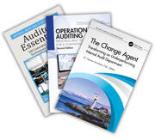
Operational Auditing Operational Auditing: Principles and Techniques for a Changing World, 2nd edition, explains the proven approaches and essential procedures to perform risk-based operational audits. It shows how to effectively evaluate the relevant dynamics associated with programs and processes, including operational, strategic, technological, financial and compliance objectives and risks. This book merges traditional internal audit concepts and practices with contemporary quality control methodologies, tips, tools and techniques. It explains how internal auditors can perform operational audits that result in meaningful findings and useful recommendations to help organizations meet objectives and improve the perception of internal auditors as high-value contributors, appropriate change agents and trusted advisors. The 2nd edition introduces or expands the previous coverage of: • Control self-assessments. • The 7 Es framework for operational quality. • Linkages to ISO 9000. • Flowcharting techniques and value-stream analysis • Continuous monitoring. • The use of Key Performance Indicators (KPIs) and Key Risk Indicators (KRIs). • Robotic process automation (RPA), artificial intelligence (AI) and machine learning (ML); and • Adds a new chapter that will examine the role of organizational structure and its impact on effective communications, task allocation, coordination, and operational resiliency to more effectively respond to market demands. Auditor Essentials Internal auditors must know many concepts, techniques, control frameworks, and remain knowledgeable despite the many changes occurring in the marketplace and their profession. This easy to use reference makes this process easier and ensures auditors can obtain needed information quickly and accurately. This book consists of 100 topics, concepts, tips, tools and techniques that relate to how internal auditors interact with internal constitutencies and addresses a variety of technical and non-technical subjects. Non-auditors have an easy-to-use guide that increases their understanding of what internal auditors do and how, making it easier for them to partner with them more effectively. The Change Agent John Taylor has been hired to transform the underperforming internal audit unit at InSports. The auditors are not reviewing what the audit committee and executive leadership consider essential for the organization’s success, their methodology is subpar, and their relationships with their clients are strained. The audit committee has been patient, but not anymore. Their mandate is clear: make clear improvements in one year or the function will be outsourced. This is the story of a visionary leader who needs a strategy to transform processes and deliver better results for stakeholders at all levels within the organization. The audit committee, all levels of management, and employees expect more from internal audit. Now, John must lead the group through 12 challenging months as they focus on what matters most when performing audit and advisory services. They must communicate results faster and better, leverage existing quality control and data analytics techniques, and, with every encounter, help the organization address strategic, operational, compliance, and financial risks. With similarities to "The Goal" and "The Phoenix Project" and leveraging Kotter’s 8-Step Process for Leading Change, follow John and the internal audit team from Boston to New York, San Francisco, London, and Buenos Aires, as they address almost insurmountable challenges in their transformation journey.
- ISBN: 9781041035039
- Editorial: CRC PRESS LLC
- Encuadernacion: Rústica
- Páginas: 1174
- Fecha Publicación: 10/01/2025
- Nº Volúmenes: 3
- Idioma:
